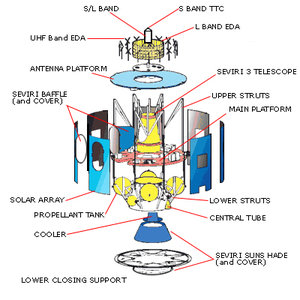Designed for the high ground of space
ESA has designed the MSG series of weather satellites for geostationary orbit, also known as the 'Clarke Belt' after Arthur C Clarke.
It was this famous science fiction writer, who first described in 1945 how orbiting approximately 38 500 km above Earth would enable a satellite to rotate keep pace with the planet's rotation - moving at around 11 000 km per hour - to remain in the same location relative to the ground.
Geostationary orbit confers many advantages on a mission, notably a footprint that stretches across more than a quarter of Earth, covering Europe, Africa, the Middle East, much of the Atlantic and the eastern edge of South America. It also makes satellite tracking and communication much simpler – an antenna has only to be pointed from the ground towards the appropriate point over the equator.
There are also disadvantages to occupying such high ground, a tenth of the distance to the Moon. It is a hostile environment: located outside of the bulk of the Earth's magnetic field, geostationary spacecraft are exposed to a broad spectrum of solar radiation, charged particles and cosmic rays, which can lead to potentially serious voltage discharges affecting internal electronics and rapid degradation of surface materials, such as solar panels and optical coverings. And almost constantly facing the Sun leads to issues of onboard thermal control and outgassing.

MSG satellite systems are constructed from radiation-hardened components, and are sheathed in distinctive Multi Layer Insulation resembling gold and silver gift wrapping. Its solar panels are built on the exterior of the 3.2 m diameter drum-shaped spacecraft, with the main SEVIRI instrument placed within the spacecraft core.
The amount of energy available from the Sun varies as it appears to drift during the course of the season, and the satellite is cast into periods of solar eclipses by the Earth during the vernal and autumn equinoxes. The onboard power system must cope with this variety, as well as the slow degradation of solar panel performance during each satellite's projected seven years of life.
Earth is not a perfect sphere, so some amount of orbital drift is inevitable. In an inheritance from the earlier generations of Meteosats, MSG satellites are spin-stabilised, meaning that they rotate counter clockwise at 100 revolutions per minute as a economical means of maintaining correct pointing attitude, this method being supplemented by small thrusters.
The satellites are designed to operate above the equator at 0º longitude but have sufficient propellant to be moved up to 50 degrees West or East as required.









